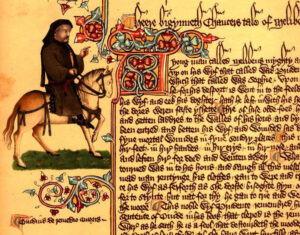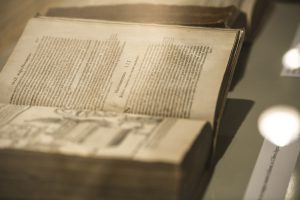So, here we are. The SIGLUM website is now officially on. Everyone is welcome to use our site and comment on our posts on the blog. We are going to talk here about our work and our projects, both individual and collaborative. We would also like to share news about events that are important to SIGLUM. We hope that this blog will be an informal space, where we can exchange ideas and information on intriguing and significant manuscripts, and related issues. We also hope it will be the place to ask questions and consult experts from related fields.

The Canterbury Tales, Ellesmere Manuscript, Huntington Library, San Marino, California, EL 26 C 9, fol. 153v
A few words about the beginnings
The research group for the study of manuscripts has been set up by Monika Opalińska (Institute of English Studies), Anna Just (Institute of German Studies) and Agnieszka Fabiańska (Special Collections at the University Library in Warsaw). Since 2018, they have been co-organizing workshops with students in the Special Collections at the University Library. During these meetings, students have had an opportunity to examine manuscripts in situ and learn the basics of working with the primary sources. It was only natural to turn this informal collaboration into a more organized form of work. Another reason to do this was the need to bring people working with manuscripts together. And so, the Research Group, named SIGLUM, was officially founded on January 25, 2021, at the Faculty of Modern Languages at the University of Warsaw.
At first, SIGLUM gathered researchers associated with the University of Warsaw, but scholars from other academic centres and institutions soon joined in. We are happy to extend our invitation to everyone interested in manuscripts, anyone who works with handwritten books and would like to learn more or look at them from a different perspective.
The most distinguishing feature of SIGLUM is its interdisciplinary character. As a group, we are interested in all sorts of manuscripts from different times and regions. We all work with handwritten sources, but we often look for different things in them. For some of us, the manuscript is a medium of historical texts or linguistic data. Others study it as an object of art or appraise its collector’s value. Yet others examine its material features and submit it to scientific analysis and restoration work.
First collaborative projects
One of the first outputs of our collaborative work in SIGLUM is a comprehensive project concerning a fragment of an 11th-century Latin psalter with Anglo-Saxon glosses. The fragment has been recently discovered in the binding of an early printed book housed in the C. K. Norwid Library in Elbląg. It is an object of great historical value and a unique finding among Polish sources. The fragment was discovered by Paulina Pludra-Żuk, Marta Czyżak and Ewa Chlebus while they were working on a Fragmentarium project Medieval manuscript fragments of Teutonic Prussia in collections of the Parker Library, Corpus Christi College, Cambridge, the C. Norwid Library in Elbląg and the University Library in Toruń as the evidence in reconstructing the history of collections.
This newly found fragment is now subject to a comprehensive analysis that involves the expertise of philologists, historians, linguists, conservators, chemists and physicists. Preliminary linguistic, palaeographical and historical analysis has led us to the conclusion that the Elbląg fragment may come from the same dismembered codex as four other fragments of parchment leaves, now housed in Cambridge University Library, Sondershausen Schlossmuseum and Haarlem, Stadsbibliotheek. According to one hypothesis, the original book may have belonged to Gunnhild, the youngest sister of Harold II – the last Anglo-Saxon king. In order to verify this hypothesis, we have decided to complement traditional methodology with non-invasive material analysis. We hope that the latter will help us to establish the elemental composition of the ink, recover the illegible parts of the document and analyse the structure of parchment. We would like to share the results of our pilot studies with the three libraries mentioned above and devise a comparative European project to examine all the extant fragments in the same way. Our project also aims to devise a digital model for the reconstruction and visualisation of the dismembered codex or, at least, the partially preserved leaves. Owing to all these analyses, we may not only thoroughly examine the extant fragments but also provide the optimal environment and better protection for them in the future.
This project is conducted in collaboration with experts from the University of Warsaw, the Polish Academy of Sciences, Mikołaj Kopernik University in Toruń and C. K. Norwid Library in Elbląg. We will keep you informed about the progress of our work.
Meetings, workshops and lectures
Throughout the academic year 2021/22, we plan to organize lectures, workshops and meetings with scholars specializing in different aspects of manuscript studies. We hope that we will be able to schedule some of these events on campus. While SIGLUM is waiting for its workspace, we will hold our meetings at the University Library’s Special Collections and the Faculty of Modern Languages at the University of Warsaw. Follow our website to learn more about the upcoming events.